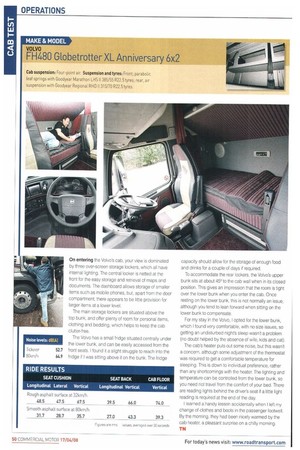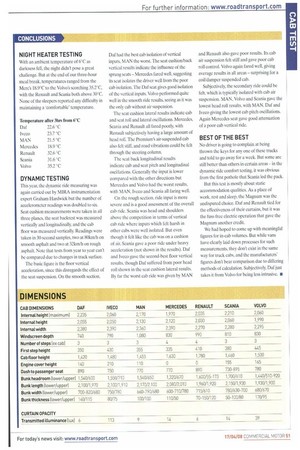FH480 Globetrotter XL Anniversary 6x2
Page 50

Page 51

If you've noticed an error in this article please click here to report it so we can fix it.
Cab suspension: Four-point air. Suspension and tyres: Front, parabolic leaf springs with Goodyear Marathon LHS 11 385/55 R22.5 tyres; rear, air suspension with Goodyear Regional RHO 11 315/70 R22.5 tyres.
On entering the Volvo's cab, your view is dominated by three over-screen storage lockers, which all have internal lighting. The central locker is netted at the front for the easy storage and retrieval of maps and documents. The dashboard allows storage of smaller items such as mobile phones, but, apart from the door compartment, there appears to be little provision for larger items at a lower level.
The main storage lockers are situated above the top bunk, and offer plenty of room for personal items, clothing and bedding, which helps to keep the cab clutter-free.
The Volvo has a small fridge situated centrally under the lower bunk, and can be easily accessed from the front seats. !found it a slight struggle to reach into the fridge if I was sitting above it on the bunk. The fridge capacity should allow for the storage of enough food and drinks for a couple of days if required.
To accommodate the rear lockers. the Volvo's upper bunk sits at about 459 to the cab wall when in its closed position. This gives an impression that the room is tight over the lower bunk when you enter the cab. Once resting on the lower bunk, this is not normally an issue, although you tend to lean forward when sitting on the lower bunk to compensate.
For my stay in the Volvo, I opted for the lower bunk, which I found very comfortable, with no size issues, so getting an undisturbed night's sleep wasn't a problem (no doubt helped by the absence of wife, kids and cat). The cab's heater puts out some noise, but this wasn't a concern, although some adjustment of the thermostat was required to get a comfortable temperature for sleeping. This is down to individual preference, rather than any shortcomings with the heater. The lighting and temperature can be controlled from the lower bunk, so you need not travel from the comfort of your bed. There are reading lights behind the driver's seat if a little light reading is required at the end of the day.
I learned a handy lesson accidentally when I left my change of clothes and boots in the passenger footwell. By the morning, they had been nicely warmed by the cab heater, a pleasant surprise on a chilly morning. TN
NIGHT HEATER TESTING
With an ambient temperature of 6°C as darkness fell, the night didn't pose a great challenge. But at the end of our three-hour meal break, temperatures ranged from the Merc's 18.9°C to the Volvo's scorching 35.2°C, with the Renault and Scania both above 30°C. None of the sleepers reported any difficulty in maintaining a 'comfortable' temperature.
This year, the dynamic ride measuring was again carried out by MIRA instrumentation expert Graham Hardwick but the number of accelerometer readings was doubled to six. Seat cushion measurements were taken in all three planes, the seat backrest was measured vertically and longitudinally, and the cab floor was measured vertically. Readings were taken in 30-second samples, two at 80km/h on smooth asphalt and two at 32km/h on rough asphalt Note that tests from year to year can't be compared due to changes in track surface.
The basic figure is the floor vertical acceleration, since this disregards the effect of the seat suspension. On the smooth section. Daf had the best cab isolation of vertical inputs. MAN the worst. The seat cushion/back vertical results indicate the influence of the sprung seats — Mercedes fared well, suggesting its seat isolates the driver well from the poor cab isolation. The Daf seat gives good isolation of the vertical inputs. Volvo performed quite well in the smooth ride results, seeing as it was the only cab without air suspension.
The seat cushion lateral results indicate cab and seat roll and lateral oscillations. Mercedes, Scania and Renault all fared poorly, with Renault subjectively having a large amount of head roll. The Premium's air-suspended cab also felt stiff, and road vibrations could be felt through the steering column.
The seat back longitudinal results indicate cab and seat pitch and longitudinal oscillations. Generally the input is lower compared with the other directions but Mercedes and Volvo had the worst results, with MAN. Iveco and Scania all faring well.
On the rough section, ride input is more severe and is a good assessment of the overall cab ride. Scania was head and shoulders above the competition in terms of vertical cab ride where inputs which felt harsh in other cabs were well isolated. But even though it felt like the cab was on a cushion of air. Scania gave a poor ride under heavy acceleration (not shown in the results). Daf and Iveco gave the second-best floor vertical results, though Dal suffered from poor head roll shown in the seat cushion lateral results. By far the worst cab ride was given by MAN and Renault also gave poor results. Its cab air suspension felt stiff and gave poor cab roll control. Volvo again fared well, giving average results in all areas — surprising for a coil/damper suspended cab.
Subjectively, the secondary ride could be felt, which is typically isolated with cab air suspension. MAN, Volvo and Scania gave the lowest head roll results, with MAN. Daf and Iveco giving the lowest cab pitch oscillations. Again Mercedes seat gave good attenuation of a poor cab vertical ride.
BEST OF THE BEST
No driver is going to complain at being thrown the keys for any one of these trucks and told to go away for a week. But some are still better than others in certain areas—in the dynamic ride comfort testing, it was obvious from the first pothole that Scania led the pack.
But this test is mostly about static accommodation qualities. As a place of work, rest and sleep, the Magnum was the undisputed choice. Daf and Renault tied for the effectiveness of their curtains, but it was the fuss-free electric operation that gave the Magnum another credit.
We had hoped to come up with meaningful figures for in-cab volumes. But while vans have clearly laid down processes for such measurements, they don't exist in the same way for truck cabs, and the manufacturers' figures don't bear comparison due to differing methods of calculation. Subjectively, Daf just takes it from Volvo for being less intrusive. •




























































































































































































